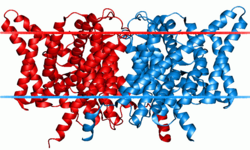| Voltage gated chloride channel | |||||||||
|---|---|---|---|---|---|---|---|---|---|
 | |||||||||
| Identifiers | |||||||||
| Symbol | Voltage_CLC | ||||||||
| Pfam | PF00654 | ||||||||
| InterPro | IPR014743 | ||||||||
| SCOP2 | 1kpl / SCOPe / SUPFAM | ||||||||
| TCDB | 2.A.49 | ||||||||
| OPM superfamily | 10 | ||||||||
| OPM protein | 1ots | ||||||||
| CDD | cd00400 | ||||||||
| |||||||||
Chloride channels are a superfamily of poorly understood ion channels specific for chloride. These channels may conduct many different ions, but are named for chloride because its concentration in vivo is much higher than other anions.[1] Several families of voltage-gated channels and ligand-gated channels (e.g., the CaCC families) have been characterized in humans.
Voltage-gated chloride channels perform numerous crucial physiological and cellular functions, such as controlling pH, volume homeostasis, transporting organic solutes, regulating cell migration, proliferation, and differentiation. Based on sequence homology the chloride channels can be subdivided into a number of groups.
- ^ Jentsch TJ, Stein V, Weinreich F, Zdebik AA (April 2002). "Molecular structure and physiological function of chloride channels". Physiological Reviews. 82 (2): 503–68. doi:10.1152/physrev.00029.2001. PMID 11917096.